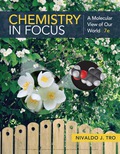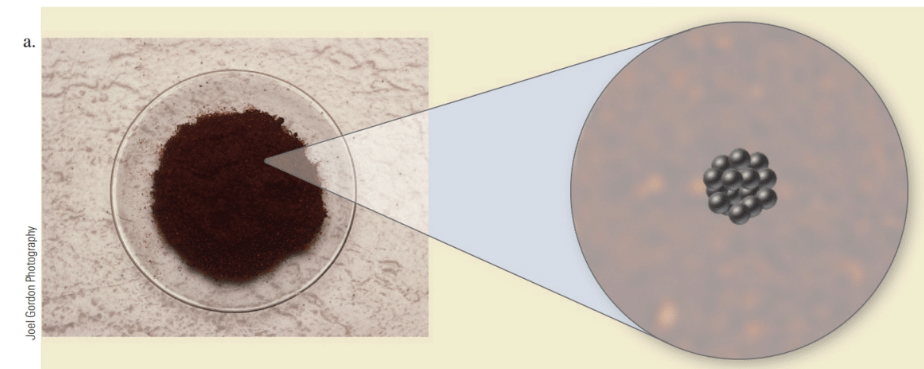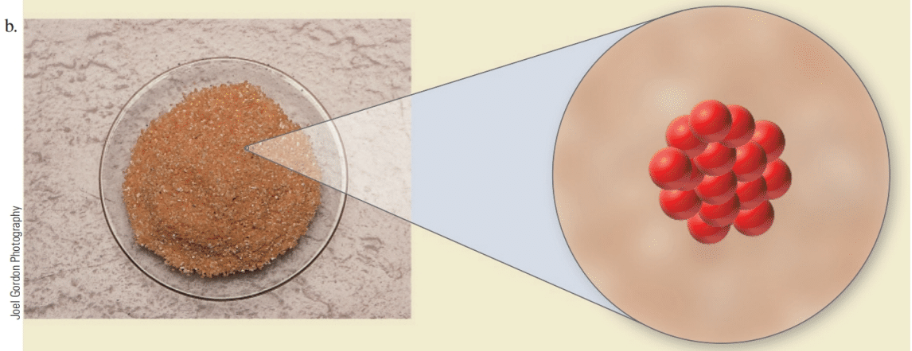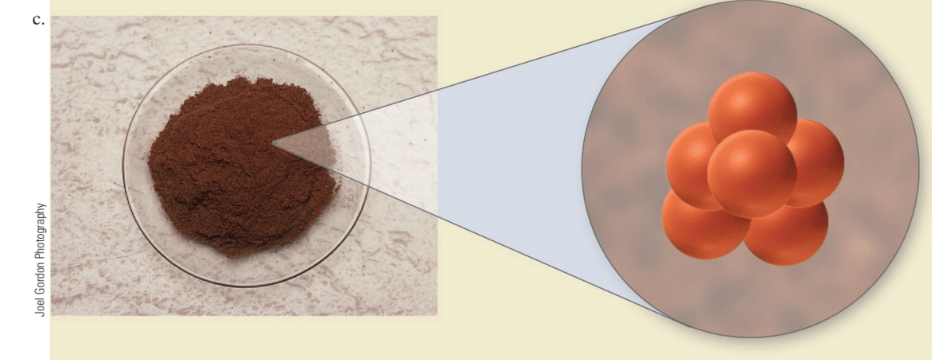
Chemistry In Focus
7th Edition
ISBN: 9781337670425
Author: Tro
Publisher: Cengage
expand_more
expand_more
format_list_bulleted
Concept explainers
Textbook Question
Chapter 3, Problem 65E
Here are three fictitious elements and a molecular view of the atoms that compose them. The molar mass of the middle element, (b), is 25 grams per dozen (g/doz). (The atoms of these fictitious elements are much larger than ordinary atoms.)



Based on the size of the atoms, do you expect the
Expert Solution & Answer
Trending nowThis is a popular solution!

Students have asked these similar questions
151.2
254.8
85.9
199.6
241.4
87.6
242.5
186.4
155.8
257.1
242.9
253.3
256.0
216.6
108.7
239.0
149.7
236.4
152.1
222.7
148.7
278.2
268.7
234.4
262.7
283.2
143.6
QUESTION: Using this group of data on salt reduced tomato sauce concentration readings answer the following questions:
1. 95% Cl Confidence Interval (mmol/L)
2. [Na+] (mg/100 mL)
3. 95% Na+ Confidence Interval (mg/100 mL)
Results
Search Results
Best Free Coursehero Unloc xb Success Confirmation of Q x
O Google Pas
alekscgi/x/lsl.exe/1o_u-IgNslkr 7j8P3jH-IQs_pBanHhvlTCeeBZbufu BYTI0Hz7m7D3ZcHYUt80XL-5alyVpwDXM TEZayFYCavJ17dZtpxbFD0Qggd1J
O States of Matter
Using a phase diagram to find a phase transition temperature or pressure
Gabr
3/5
he pressure above a pure sample of solid Substance X at 101. °C is lowered. At what pressure will the sample sublime? Use the phase diagram of X below to
nd your answer.
pressure (atm)
24-
12
solid
liquid
gas
200
400
temperature (K)
600
ote: your answer must be within 0.15 atm of the exact answer to be graded correct.
atm
Thanation
Check
© 2025 McGraw Hill LLC. All Rights Reserved. Terms of Use | Privacy Center I
Q Search
L³
ملة
301.7
348.9
193.7
308.6
339.5
160.6
337.7
464.7
223.5
370.5
326.6
327.5
336.1
317.9
203.8
329.8
221.9
331.7
211.7
309.6
223.4
353.7
334.6
305.6
340.0
304.3
244.7
QUESTION: Using this group of data on regular tomato sauce concentration readings answer the following questions:
1. 95% Cl Confidence Interval (mmol/L)
2. [Na+] (mg/100 mL)
3. 95% Na+ Confidence Interval (mg/100 mL)
Chapter 3 Solutions
Chemistry In Focus
Ch. 3 - Determining the Number of Protons and Electrons in...Ch. 3 - Prob. 3.2YTCh. 3 - Determining Protons, Neutrons, and Electrons How...Ch. 3 - Calculating Atomic Mass Magnesium has three...Ch. 3 - The Mole Concept A diamond, which is pure carbon,...Ch. 3 - The Mole Concept II Calculate the number of atoms...Ch. 3 - Your friend tells you about an article that he...Ch. 3 - Prob. 2SCCh. 3 - Prob. 3SCCh. 3 - Copper is composed of two naturally occurring...
Ch. 3 - Prob. 5SCCh. 3 - Which pair of elements do you expect to be most...Ch. 3 - Which statement is true of the quantum mechanical...Ch. 3 - Why is it important to understand atoms?Ch. 3 - Prob. 2ECh. 3 - What defines an element? How many naturally...Ch. 3 - Prob. 4ECh. 3 - Prob. 5ECh. 3 - Prob. 6ECh. 3 - Prob. 7ECh. 3 - Prob. 8ECh. 3 - Prob. 9ECh. 3 - Prob. 10ECh. 3 - Explain the quantum mechanical model for the atom....Ch. 3 - Give two examples of each: a. alkali metal b....Ch. 3 - Which elements exist as diatomic molecules?Ch. 3 - Explain the difference and similarity between...Ch. 3 - Prob. 15ECh. 3 - Determine the charge of each of the following: a...Ch. 3 - Determine the number of protons and electrons in...Ch. 3 - Determine the number of protons and electrons in...Ch. 3 - Give the atomic number (Z) and the mass number (A)...Ch. 3 - Prob. 20ECh. 3 - The following isotopes have applications in...Ch. 3 - The following isotopes are important in nuclear...Ch. 3 - 14C is used in carbon dating of artifacts....Ch. 3 - 40K is used to measure the age of Earth. Determine...Ch. 3 - Prob. 25ECh. 3 - Prob. 26ECh. 3 - Give electron configurations according to the Bohr...Ch. 3 - Give electron configurations according to the Bohr...Ch. 3 - Prob. 29ECh. 3 - How many valence electrons are in each element of...Ch. 3 - Prob. 31ECh. 3 - Draw electron configurations for each of the...Ch. 3 - Which two of the following elements would you...Ch. 3 - Group the following elements into three similar...Ch. 3 - We have seen that the reactivity of an element is...Ch. 3 - What is the electron configuration of Mg2+? How...Ch. 3 - Classify each of the following elements as a...Ch. 3 - Classify each of the following as a metal, a...Ch. 3 - Calculate the atomic mass of neon (Ne), which is...Ch. 3 - An element has two naturally occurring isotopes....Ch. 3 - A fictitious element has two naturally occurring...Ch. 3 - Copper has two naturally occurring isotopes. Cu-63...Ch. 3 - How many moles of titanium are present in 124 g of...Ch. 3 - Prob. 44ECh. 3 - How many moles are there in each sample? a. 45 mg...Ch. 3 - How many moles are there in each sample? a. 55.0 g...Ch. 3 - What is the mass of each sample? a.1.8 mol S...Ch. 3 - What is the mass of each sample? a.2.75 mol Fe...Ch. 3 - Determine the number of atoms in each sample....Ch. 3 - Determine the number of atoms in each sample....Ch. 3 - How many Ag atoms are present in a piece of pure...Ch. 3 - How many platinum atoms are in a pure platinum...Ch. 3 - A pure gold necklace has a volume of 1.8cm3. How...Ch. 3 - A titanium bicycle component has a volume of...Ch. 3 - An iron sphere has a radius of 3.4 cm. How many...Ch. 3 - Calculate the number of atoms in the universe. The...Ch. 3 - The introduction to this chapter states that...Ch. 3 - Suppose the absolute value of the charge of the...Ch. 3 - When we refer to doughnuts or cookies, we often...Ch. 3 - Prob. 60ECh. 3 - Why does Avogadros number have such an odd value?...Ch. 3 - Prob. 62ECh. 3 - Prob. 63ECh. 3 - Prob. 64ECh. 3 - Here are three fictitious elements and a molecular...Ch. 3 - Prob. 66ECh. 3 - Gather any two of the following items, measure...
Knowledge Booster
Learn more about
Need a deep-dive on the concept behind this application? Look no further. Learn more about this topic, chemistry and related others by exploring similar questions and additional content below.Similar questions
- Search Results Search Results Best Free Coursehero Unlo x b Success Confirmation of Q aleks.com/alekscgi/x/sl.exe/10_u-lgNslkr7j8P3jH-IQs_pBan HhvlTCeeBZbufu BYTIOHz7m7D3ZcHYUt80XL-5alyVpwDXM TEZayFYCav States of Matter Using a phase diagram to find a phase transition temperature or pressure Use the phase diagram of Substance X below to find the temperature at which X turns to a gas, if the pressure above the solid is 3.7 atm. pressure (atm) 0. 32- 16 solid liquid gas 200 temperature (K) Note: your answer must be within 20 °C of the exact answer to be graded correct. Дос Xarrow_forwardConsider the reaction below to answer the following questions: Acetoacetic ester can be prepared by the Claisen self-condensation reaction of ethyl acetate. 1. NaOEt, EtOH H&C OCH CH3 2 H30 H3C CH2 OCH2CH3 A. Write the complete stepwise mechanism for this reaction. Show all electron flow with arrows and draw all intermediate structures. B. Ethyl acetate can be prepared from ethanol as the only organic starting material. Show all reagents and structures for all intermediates in this preparation. C. Give the structures of the ester precursors for the following Claisen condensation product and formulate the reaction. OEtarrow_forwardUse the phase diagram of Substance X below to find the temperature at which X turns to a gas, if the pressure above the solid is 3.7 atm. pressure (atm) 32 16 solid liquid gas 0 0 200 temperature (K) Note: your answer must be within 20 °C of the exact answer to be graded correct. Шос ☑ كarrow_forward
- Starting from bromoethane, how could you prepare the following compounds: a. Ethanol. b. Acetaldehyde f. Acetone. e. 2-Propanol i. Acetoacetic ester. d. 2-Bromoacetic acid. c. Acetic acid g. Acetamide. j. Ethylmalonate k. Gama ketoacid. h. Ethyl magnesium bromide.arrow_forward- The pressure above a pure sample of solid Substance X at 60. °C is raised. At what pressure will the sample melt? Use the phase diagram of X below to find your answer. pressure (atm) 02 0.4 solid Hliquid gas 0 0 200 400 600 temperature (K) Note: your answer must be within 0.025 atm of the exact answer to be graded correct. ☐ atmarrow_forward15. What is the order of decreasing reactivity towards nucleophilic acyl substitution for the carboxylic acid derivatives? (most reactive first) 0 O H3C COC CH3 H₂C C N(CH3)2 H3C C OCH3 A. a. I, 11, 111, b. I, III, IV, II C. II, IV, III, I ° (CH3)2CH C OCH3 IV d. II, I, III, IV B. R COCR 0 0 0 13= RC NH2 RC OR RC CI === IV a. I, III, II, IV b. II, III, I, IV C. III, II, I, IV d. IV, I, III, IIarrow_forward
- Draw the formula of the product obtained by reacting D-Tallose with bromine water.arrow_forwardChoose the best reagent(s) for carrying out the following conversions from the list below. Place the letter corresponding to the best choice in the blank to the left of the conversion. a. KMnO4, H3O+ b. Tollens' Reagent [oxidizing reagent] C. NaBH4, ethanol d. 1. BH3 2. H3O+ e. 1. CH3MgBr, ether 2. H3O+ f. CrO3, H2SO4, H₂O g. 1. Mg, ether 2. CO2 3. H3O+ h. 1. NaCN 2. H2SO4, H2, heat i. O3, then Zn and HOAC j. CH₂I A. B. C. CH CH=CHCH2COOH Br CEN CH COOH + HOOCCH COOH COOH 010 CH3arrow_forwardDraw the structures for each of the intermediates in the boxes provided for the synthesis below. OCH3 Fe HO HNO (CHOO pynding H₂504 LHNO2 NACH-I Fa H₂O HCL HNO 180arrow_forward
- Provide structure(s) for the starting material(s), reagent(s) or the major organic product(s) of each of the following reactions or sequences of reactions. Show all relevant stereochemistry [three only] A. o 11 (CH3)CH — C— C ether (CH3)2CH-C-O-C-CH3 B. CH3 CHy CI Staf OH C. HC OCHS + H₂Oarrow_forwardConsider the reaction sequence below to answer the following questions: EtO Compound X 1. NaOEt, EtOH OEt Br CO₂Et NaOEt, EtOH Compound Z CO₂Et Compound Y A. Compound X, diethyl propanedioate, is more commonly known as a. ethyl acetoacetate b. acetoacetic ester C. oxalic ester d. malonic ester 3. Write the complete stepwise mechanism for the conversion of Compound X into Compound Y. Show all electron flow with arrows and draw all intermediate structures.arrow_forwardClassify each of the following nitrogen atoms in the following compounds as primary, secondary, tertiary, or quaternary [three only] CH3 HO-CHCHNHCH3 A. B. C. H&C CH3 D. HO phedrine CH2CHCH3 amphetamine NH₂ mepiquat chloride faxofenadine OH H&C CH CO₂Harrow_forward
arrow_back_ios
SEE MORE QUESTIONS
arrow_forward_ios
Recommended textbooks for you
 Chemistry for Engineering StudentsChemistryISBN:9781337398909Author:Lawrence S. Brown, Tom HolmePublisher:Cengage Learning
Chemistry for Engineering StudentsChemistryISBN:9781337398909Author:Lawrence S. Brown, Tom HolmePublisher:Cengage Learning Chemistry: The Molecular ScienceChemistryISBN:9781285199047Author:John W. Moore, Conrad L. StanitskiPublisher:Cengage LearningChemistry: Matter and ChangeChemistryISBN:9780078746376Author:Dinah Zike, Laurel Dingrando, Nicholas Hainen, Cheryl WistromPublisher:Glencoe/McGraw-Hill School Pub Co
Chemistry: The Molecular ScienceChemistryISBN:9781285199047Author:John W. Moore, Conrad L. StanitskiPublisher:Cengage LearningChemistry: Matter and ChangeChemistryISBN:9780078746376Author:Dinah Zike, Laurel Dingrando, Nicholas Hainen, Cheryl WistromPublisher:Glencoe/McGraw-Hill School Pub Co
 Chemistry: Principles and ReactionsChemistryISBN:9781305079373Author:William L. Masterton, Cecile N. HurleyPublisher:Cengage Learning
Chemistry: Principles and ReactionsChemistryISBN:9781305079373Author:William L. Masterton, Cecile N. HurleyPublisher:Cengage Learning Introduction to General, Organic and BiochemistryChemistryISBN:9781285869759Author:Frederick A. Bettelheim, William H. Brown, Mary K. Campbell, Shawn O. Farrell, Omar TorresPublisher:Cengage Learning
Introduction to General, Organic and BiochemistryChemistryISBN:9781285869759Author:Frederick A. Bettelheim, William H. Brown, Mary K. Campbell, Shawn O. Farrell, Omar TorresPublisher:Cengage Learning

Chemistry for Engineering Students
Chemistry
ISBN:9781337398909
Author:Lawrence S. Brown, Tom Holme
Publisher:Cengage Learning

Chemistry: The Molecular Science
Chemistry
ISBN:9781285199047
Author:John W. Moore, Conrad L. Stanitski
Publisher:Cengage Learning

Chemistry: Matter and Change
Chemistry
ISBN:9780078746376
Author:Dinah Zike, Laurel Dingrando, Nicholas Hainen, Cheryl Wistrom
Publisher:Glencoe/McGraw-Hill School Pub Co


Chemistry: Principles and Reactions
Chemistry
ISBN:9781305079373
Author:William L. Masterton, Cecile N. Hurley
Publisher:Cengage Learning

Introduction to General, Organic and Biochemistry
Chemistry
ISBN:9781285869759
Author:Frederick A. Bettelheim, William H. Brown, Mary K. Campbell, Shawn O. Farrell, Omar Torres
Publisher:Cengage Learning
NEET Chemistry | Group 14 Carbon Family | Theory & Problem Solving | In English | Misostudy; Author: Misostudy;https://www.youtube.com/watch?v=enOGIrcHh54;License: Standard YouTube License, CC-BY